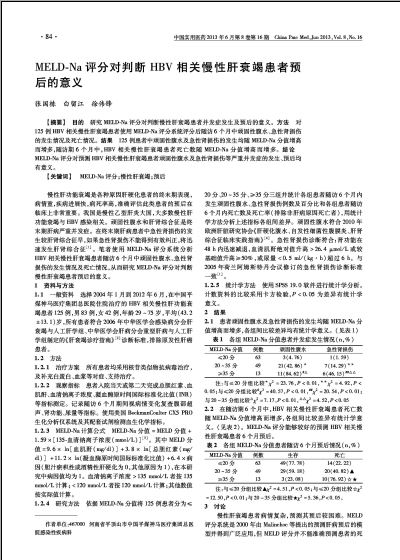MELD—Na评分对判断HBV相关慢性肝衰竭患者预后的意义(2)
 |
| 第1页 |
参见附件。
参 考 文 献
[1] GarciaTsao G, Parikh CR, Viola A.Acute kidney injury in cirrhosis. Hepatology,2008,48(6):20642077.
[2] 中华医学会感染病学分会肝衰竭与人工肝学组.中华医学会肝病学分会重型肝病与人工肝学组.肝衰竭诊疗指南.中华肝脏病杂志,2006,14(09):643646.
[3] Biggins SW, Kim ER, Terrault NA, et al. Evidencebased incorporation of serum sodium concentration into MELD. Gastroenterology,2006,130(6):16521660.
[4] Gines P, Angeli P, Lenz K, et al. EASL clinical practice guidelines on the management of ascites, spontaneous bacterial peritonitis, and hepatorenal syndrome in cirrhosis. Journal of Hepatology,2010,53(3):397417.
[5] 张俊勇,秦成勇,贾继东,等.肝硬化患者血清钠特点及含钠终末期肝病模型对预后的判断价值.中华肝脏病杂志,2012,20(2):108111.
[6] Hsu CY, Lin HC, Huang YH, et al. Comparison of the model for endstage liver disease (MELD), MELDNa and MELDNa for outcome prediction in patients with acute decompensated hepatitis. Digestive and liver disease,2010,42(2):137142.
[7] Choi PC, Kim HJ, Choi WH, et al. Model for endstage liver disease, model for endstage liver diseasesodium and ChildTurcottePugh scores over time for the prediction of complications of liver cirrhosis. Liver International,2009,29(2):221226.
您现在查看是摘要介绍页,详见PDF附件。